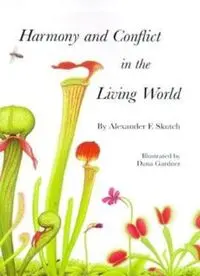
Harmony and Conflict in the Living World PDF
Preview Harmony and Conflict in the Living World
Page iii Harmony and Conflict in the Living World By Alexander F. Skutch Illustrated by Dana Gardner Page iv Also by Alexander F. Skutch and illustrated by Dana Gardner A Bird Watcher's Adventures in Tropical America (Austin, 1977) A Naturalist on a Tropical Farm (Berkeley, 1980) New Studies of Tropical American Birds (Cambridge, Mass., 1981) Birds of Tropical America (Austin, 1983) Nature through Tropical Windows (Berkeley, 1983) Life of the Woodpecker (Ithaca, 1985) Helpers at Birds' Nests: A Worldwide Survey of Cooperative Breeding and Related Behavior (Iowa City, 1987) A Naturalist Amid Tropical Splendor (Iowa City, 1987) Life of the Tanager (Ithaca, 1989) (with F. Gary Stiles) A Guide to the Birds of Costa Rica (Ithaca, 1991) Life of the Pigeon (Ithaca, 1991) Origins of Nature's Beauty (Austin, 1992) The Minds of Birds (College Station, 1996) Orioles, Blackbirds and Their Kin (Tucson, 1996) Antbirds and Ovenbirds: Their Lives and Homes (Austin, 1996) Life of the Flycatcher (Norman, 1997) Trogons, Laughing Falcons, and Other Neotropical Birds (College Station, 1999) Libraryof Congress Cataloging-in-Publication Data Skutch, Alexander Frank, 1904 Harmony and conflict in the living world / by Alexander F. Skutch; illustrated by Dana Gardner. p. cm. Includes bibliographical refrerences (p.). ISBN 0-8061-3231-0 (alk. paper) 1. Life (Biology)Philosophy. I. Title. QH501 .S54 2000 570'.1-dc21 99-055168 The paper in this book meets the guidelines for permanence and durability of the Committee on Production Guidelines for Book Longevity of the Council on Library Resources, Inc.¥ Copyright © 2000 by the University of Oklahoma Press, Norman, Publishing Division of the University. All rights reserved. Manufactured in the U.S.A. 1 2 3 4 5 6 7 8 9 10 Page v Contents Preface ix 1. A Realm of Paradoxes 3 2. The Individual and Its Species 21 3. The Twofold Nature of Animals 33 4. Mutual Aid and Social Relations 53 5. Exploitation and Cooperation 79 6. Paradoxical Plants 97 7. Three Biological Heresies 131 8. Biodiversity or Biocompatibility? 151 9. The Troubled Childhood of Intelligence 163 Epilogue: The Failure of Success? 197 Bibliography 203 Index 209 Page vii Illustrations 1. Chinstrap Penguins, Pygoscelis antartica 36 2. Blue-tailed Bee-eaters, Merops superciliosus 65 3. Sociable Weavers, Philetairus socius, at their nest 74 4. Strangler fig aerial roots 83 5. Purple pitcher plant, Sarracenia purpurea 100 6. Cobra lily, Darlingtonia californica 102 7. Nepenthes edwardsiana, tropical pitcher plant 104 8. Nepenthes rajah, tropical pitcher plant 105 9. West Australian pitcher plant, Cephalotus follicularis 107 10. Genlisea sp., branch, foliage, and traps 109 11. Round-leaved sundew, Drosera rotundifolia, plant and a glandular leaf enlarged 112 12. Venus's-flytrap, Dionaea muscipula, with traps open and closed 115 on prey 13. Common butterwort, Pinguicula vulgaris, flowering plant 118 14. Greater bladderwort, Utricularia vulgaris, flowering stem and submerged leaves with bladders 120 15. Greater bladderwort, Utricularia vulgaris, bladder showing valve and appendages 121 16. Greater bladderwort, Utricularia vulgaris, internal structure of bladder 122 17. Greater bladderwort, Utricularia vulgaris, bladder set and expanded 123 18. Satin Bower-bird, Ptilonorhynchus violaceus, at bower with ornaments 189 Page ix Preface If I were asked to characterize the living world in one word, the word would be paradoxical. A paradox is a conclusion that, although possibly true, appears not to follow logically from its premises, or a situation incompatible with its antecedents. Paradoxes are inconsistencies, contrarieties in the development of a doctrine or a system. The living world, incongruously replete with beauty and ugliness, delight and terror, love and hatred, cooperation and exploitation, life and death, is a fabric of paradoxes. The most glaring of nature's incongruities is the internecine strife between organisms that, from the least to the greatest, have so much in common. The more intensively they are studied, the more similarities are disclosed, in genetic control and physiological processes, between creatures that vary immensely in form, habitat, and activities. The life and health of each are preserved by a high degree of internal harmony among diverse organs and functions, yet their external relations are frequently far from harmonious. To understand this paradoxical situation, we must look deeply into the nature of the universe, which, as I explained in Life Ascending (1985), is pervaded by an unremitting tendency to arrange its materials in patterns of increasing amplitude, complexity, and coherencethe process of harmonization that brings order out of chaos. On a vast scale it has condensed great quantities of matter, originally present as intergalactic clouds of gases and dust, into stars, planets, and their satellites. It has set the planets in orbits around the stars, the satellites in courses around the planets, in dynamic systems so balanced and stable that, as in our solar system, they endure for long ages. On a small scale, the same process is evident in the union of atoms in molecules of innumerable kinds, and the alignment of atoms or molecules in enduring
